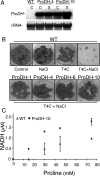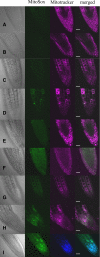Unraveling delta1-pyrroline-5-carboxylate-proline cycle in plants by uncoupled expression of proline oxidation enzymes
- PMID: 19635803
- PMCID: PMC2785336
- DOI: 10.1074/jbc.M109.009340
Unraveling delta1-pyrroline-5-carboxylate-proline cycle in plants by uncoupled expression of proline oxidation enzymes
Abstract
The two-step oxidation of proline in all eukaryotes is performed at the inner mitochondrial membrane by the consecutive action of proline dehydrogenase (ProDH) that produces Delta(1)-pyrroline-5-carboxylate (P5C) and P5C dehydrogenase (P5CDH) that oxidizes P5C to glutamate. This catabolic route is down-regulated in plants during osmotic stress, allowing free Pro accumulation. We show here that overexpression of MsProDH in tobacco and Arabidopsis or impairment of P5C oxidation in the Arabidopsis p5cdh mutant did not change the cellular Pro to P5C ratio under ambient and osmotic stress conditions, indicating that P5C excess was reduced to Pro in a mitochondrial-cytosolic cycle. This cycle, involving ProDH and P5C reductase, exists in animal cells and now demonstrated in plants. As a part of the cycle, Pro oxidation by the ProDH-FAD complex delivers electrons to the electron transport chain. Hyperactivity of the cycle, e.g. when an excess of exogenous l-Pro is provided, generates mitochondrial reactive oxygen species (ROS) by delivering electrons to O(2), as demonstrated by the mitochondria-specific MitoSox staining of superoxide ions. Lack of P5CDH activity led to higher ROS production under dark and light conditions in the presence of Pro excess, as well as rendered plants hypersensitive to heat stress. Balancing mitochondrial ROS production during increased Pro oxidation is therefore critical for avoiding Pro-related toxic effects. Hence, normal oxidation of P5C to Glu by P5CDH is key to prevent P5C-Pro intensive cycling and avoid ROS production from electron run-off.
Figures










Similar articles
-
Context of action of proline dehydrogenase (ProDH) in the Hypersensitive Response of Arabidopsis.BMC Plant Biol. 2014 Jan 13;14:21. doi: 10.1186/1471-2229-14-21. BMC Plant Biol. 2014. PMID: 24410747 Free PMC article.
-
Proline dehydrogenase contributes to pathogen defense in Arabidopsis.Plant Physiol. 2011 Apr;155(4):1947-59. doi: 10.1104/pp.110.167163. Epub 2011 Feb 10. Plant Physiol. 2011. PMID: 21311034 Free PMC article.
-
Proline dehydrogenase is a positive regulator of cell death in different kingdoms.Plant Signal Behav. 2011 Aug;6(8):1195-7. doi: 10.4161/psb.6.8.15791. Epub 2011 Aug 1. Plant Signal Behav. 2011. PMID: 21757996 Free PMC article.
-
Regulation of levels of proline as an osmolyte in plants under water stress.Plant Cell Physiol. 1997 Oct;38(10):1095-102. doi: 10.1093/oxfordjournals.pcp.a029093. Plant Cell Physiol. 1997. PMID: 9399433 Review.
-
P5C as an Interface of Proline Interconvertible Amino Acids and Its Role in Regulation of Cell Survival and Apoptosis.Int J Mol Sci. 2021 Oct 29;22(21):11763. doi: 10.3390/ijms222111763. Int J Mol Sci. 2021. PMID: 34769188 Free PMC article. Review.
Cited by
-
Requirement of proline synthesis during Arabidopsis reproductive development.BMC Plant Biol. 2012 Oct 13;12:191. doi: 10.1186/1471-2229-12-191. BMC Plant Biol. 2012. PMID: 23062072 Free PMC article.
-
Non-redundant functions of two proline dehydrogenase isoforms in Arabidopsis.BMC Plant Biol. 2010 Apr 19;10:70. doi: 10.1186/1471-2229-10-70. BMC Plant Biol. 2010. PMID: 20403182 Free PMC article.
-
H2O2-Responsive Hormonal Status Involves Oxidative Burst Signaling and Proline Metabolism in Rapeseed Leaves.Antioxidants (Basel). 2022 Mar 16;11(3):566. doi: 10.3390/antiox11030566. Antioxidants (Basel). 2022. PMID: 35326216 Free PMC article.
-
Characteristics and expression patterns of the aldehyde dehydrogenase (ALDH) gene superfamily of foxtail millet (Setaria italica L.).PLoS One. 2014 Jul 2;9(7):e101136. doi: 10.1371/journal.pone.0101136. eCollection 2014. PLoS One. 2014. PMID: 24988301 Free PMC article.
-
Proline and ROS: A Unified Mechanism in Plant Development and Stress Response?Plants (Basel). 2024 Dec 24;14(1):2. doi: 10.3390/plants14010002. Plants (Basel). 2024. PMID: 39795262 Free PMC article. Review.
References
-
- Hu C. A., Donald S. P., Yu J., Lin W. W., Liu Z., Steel G., Obie C., Valle D., Phang J. M. (2007) Mol. Cell Biochem. 295, 85–92 - PubMed
-
- Hare P. D., Cress W. A. (1997) Plant Growth Regul. 21, 79–102
-
- Delauney A. J., Verma D. P. S. (1993) Plant J. 4, 215–223
-
- Chen T. H., Murata N. (2002) Curr. Opin. Plant Biol. 5, 250–257 - PubMed
Publication types
MeSH terms
Substances
LinkOut - more resources
Full Text Sources
Molecular Biology Databases
Research Materials
Miscellaneous

